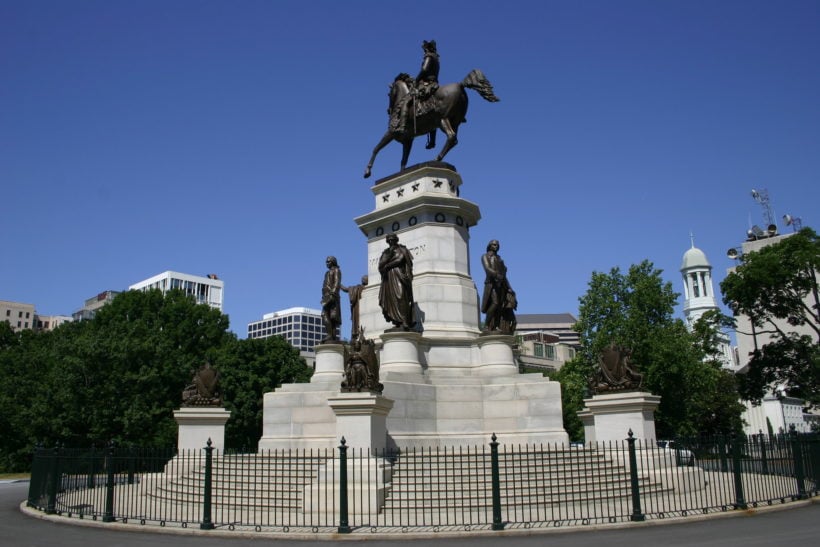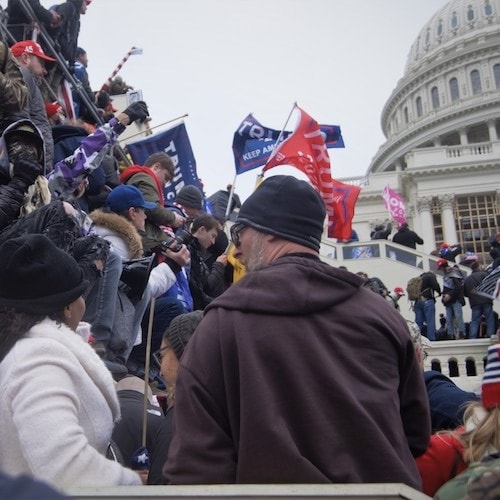Minutes before Trump told his supporters to march on the US Capitol and to “fight like hell,” he reminded them of a “little law” against attacking national monuments: “You hurt our monuments, you hurt our heroes, you go to jail for ten years.” This is Trump’s executive order on protecting US monuments of June 2020. Why did Trump talk about jail sentences for monument attacks in the same speech that incited a mob attack on one of the nation’s most important monuments?
The US are in the midst of a war over how to remember US history. Remembrance of January 6 is the most recent battle in this war. How the event should be called is already fought over. Democrats and their supporters call it an “attack,” a “riot,” an “insurrection,” and an “attempted coup.” They see the events as unequivocally bad. Trump supporters are more ambiguous. Some still call it a “patriotic” demonstration or a “tour” of the Capitol. Some agree that these were “riots,” but deny that they amounted to an “insurrection.” Some agree that these were violent riots but deny that the rioters were Trump supporters. Instead, left-wing agitators and FBI operatives staged the attack to discredit Trump.
The US are in the midst of a war over how to remember US history. Remembrance of January 6 is the most recent battle in this war.
Six people died during or as a result of the attack. 140 police officers were violently assaulted. The Department of Justice started the largest investigation in its history. By mid-2022, more than 800 people had been identified and charged with crimes, dozens have been convicted to prison sentences. Most of the attackers were charged with unlawful entry into, or violence at, a restricted government building; others have been charged with obstruction of an official proceeding; a few have been charged for seditious conspiracy.
The court charges do not explain what motivated the attackers. Did they want to attack democracy and the peaceful transfer of power? Did they want to defend democracy and the lawful transfer of power? Was this an assault on Congress as an institution? Was it a smear campaign against Trump? An assault on the Capitol as the symbolic seat of government? An attack on the electoral process? An attempted assault on specific individuals, such as Vice President Mike Pence? An attack on members of Congress who rejected Trump’s stolen election narrative?

Image by Dave R. Zeman, courtesy of Flickr.com.
To understand what happened on January 6, we need to understand the war over how to remember US history. Both sides interpret January 6 within different historical frames. Those against Trump see January 6 as continuous with attacks on American democracy, right-wing politics, and white supremacy. In turn, many Trump supporters see the march on the Capitol as a patriotic re-enactment of 1776 and the struggle for Independence. Since announcing his candidacy, Trump had pledged to “drain the swamp,” to attack a corrupt Washington elite and restore America to “the people.” To some of Trump’s supporters, attacking the Capitol as a symbol of the “swamp” made sense.
Speaking from the Capitol in January 2022 to mark the first anniversary of the attack, President Biden rejected the claim that the “deadly assault” on “this sacred place” was a patriotic uprising like 1776. It was a lie “that the mob who sought to impose their will through violence are the nation’s true patriots. Is that what you thought when you looked at the mob ransacking the Capitol, destroying property, literally defecating in the hallways, rifling through desks of senators and representatives, hunting down members of congress? Patriots? Not in my view.”
In June 2022, Bennie Thompson, the Chairman of the National Commission to Investigate the January 6 Attack on the United States Capitol Complex, opened the public hearings with a series of historical framings. Thompson argued that justifications of the attack were similar to justifications of slavery. He described January 6 as an attack on American democracy, similar to British troops burning down the Capitol in 1814. He reminded the audience that the Civil War was a war against the United States, and that the oath to defend the US Constitution against attacks “both foreign and domestic” originates in the Civil War. In the Civil War, the domestic attackers were soldiers of the Confederate South. In 2021, the domestic attackers were the Trump supporters. The 2021 attackers were like Confederates fighting for white supremacy.
In his speech on January 6, Trump placed the stolen election within a history of “Radical Left” attacks on US monuments.
Trump pushes a very different narrative. The true American patriots were the people who marched on the Capitol. They were fighting for fair elections. The stolen election of 2020 was another episode in a long history of injustice against America’s “great patriots.” In a January 6 tweet, Trump said that “these are the things and events that when a sacred landslide election victory is so unceremoniously & viciously stripped away from great patriots who have been badly & unfairly treated for so long.” Trump convinced his supporters that the presidency was stolen from him. A third of all Americans, and two thirds of Republican voters, believe in the Big Lie.
In his speech on January 6, Trump placed the stolen election within a history of “Radical Left” attacks on US monuments. Both were “egregious assaults on our democracy,” and both had to be fought against. Trump reminded his supporters of the widespread unrests in 2020. Hundreds of monuments had been destroyed in these attacks. National monuments in honor of Washington, Jefferson, and Lincoln had been targeted by leftist “cancel culture.” Trump assured the crowd that “we will not take the name off the Washington Monument.” He claimed that “they wanted to get rid of Jefferson Memorial, either take it down or just put somebody else in there.” Trump said that “they’ll knock out Lincoln, too … they’ll been taking his statue down.” “They” are an unpatriotic conspiracy of Democrats, Black Lives Matter, Marxists and Anarchists.

Image by Virginia General Assembly, courtesy of Flickr.com.
In May 2020, George Floyd, a 46-year-old African American, was killed by police officers in Minneapolis. When videos of Floyd’s murder went viral, protests erupted across the US and in sixty countries worldwide. During the protests, hundreds of historic monuments were defaced, destroyed, or removed. Monuments to Confederate history were the top targets. In 2020, over a hundred Confederate monuments were demolished. Statues of founding fathers such as Thomas Jefferson and George Washington were attacked for their histories of slave ownership.
To quell the attacks, Trump signed the Executive Order on Protecting American Monuments, Memorials, and Statues and Combating Recent Criminal Violence in June 2020. The order countered “a sustained assault on the life and property of civilians, law enforcement officers, government property, and revered American monuments such as the Lincoln Memorial.” The attackers were driven by extremist ideologies of “Marxism” and “Anarchy.” The extremists had a “desire to indiscriminately destroy anything that honors our past and to erase from the public mind any suggestion that our past may be worth honoring, cherishing, remembering, or understanding.” The order states that “my administration will not allow violent mobs incited by a radical fringe to become the arbiters of the aspects of our history that can be celebrated in public spaces.” To defend monuments was to “defend the fundamental truth that America is good, her people are virtuous, and that justice prevails.”
Trump’s Independence Day speech 2020 at Mount Rushmore also centered on monument attacks. Trump described the 2020 protests as “a merciless campaign to wipe out our history, defame our heroes, erase our values, and indoctrinate our children.” Attacks on historic monuments were attacks on “our country, and all of its values, history, and culture.” Destroying monuments amounted to a treasonous attack on American democracy: “Make no mistake: this left-wing cultural revolution is designed to overthrow the American Revolution.” The people who attack national monuments in the name of racial justice were, in fact, attacking the foundations of racial justice: “They would tear down the principles that propelled the abolition of slavery in America.”
Attacks on historic monuments were attacks on “our country, and all of its values, history, and culture.” Destroying monuments amounted to a treasonous attack on American democracy.
The war over how to tell US history shifted to monuments in 2015, when a white supremacist killed nine African Americans in a church in Charleston, Louisiana. These racist murders accelerated the removal of Confederate statues across the South. In response to these removals, right-wing activists organized to defend the monuments. Trying to stop the removal of a statue of Confederate General Lee at Charlottesville, Virginia, far-right groups arrived for the “Unite the Right” rally August 2017. At a torch-lit march, the right-wingers shouted “You will not replace us,” “Jews will not displace us,” and “White Lives Matter.” The Charlottesville rally enacted the Great Replacement theory, which holds that leftist elites are systematically undermining whites in favour of non-white races. The protesters articulated an existential connection between Confederate statues and the white race: destroying these statues was the same as destroying white people. The next day, right-wingers congregated around Lee’s monument, large groups of counter-protesters gathered around them. One of the right-wingers rammed his car into a group of counter protesters, killing one and injuring 35. After Charlottesville, Trump defended the right-wingers: “You also had people that were very fine people, on both sides.” Most of the people at the rally were good citizens who just wanted to defend a cherished monument. American heritage should not be removed, history should not be rewritten: “Many of those people were there to protest the taking down of the statue of Robert E. Lee … I wonder, is it George Washington next week? And is it Thomas Jefferson the week after. You know, you really do have to ask yourself, where does it stop?”
The flags waived on January 6 abounded with historical references. Many commentators picked up on Civil War iconography, some are even seeing a “new Civil War” on the horizon. But references to American Independence dominated. ”We the People” banners quoted the first line of the US Constitution. The “Betsy Ross” flag, with 13 stars for the first US states, glorifies the nation in its original form. The motto “Don’t tread on me” with the rattlesnake features on several Revolutionary flags: the “Culpeper Minutemen,” the “Gadsen,” and the “South Carolina Navy.” The “Three Percenters” flag represents an extremist group who claim that it only took three percent of the American population to kick out the British in 1776, meaning that a handful of armed patriots are capable of overthrowing a tyrannical government.
Many attackers thought they were repeating the American Revolution.
Attackers later explained that they wanted to defend the country and their democratic ideals just like the founders had done in 1776. The attack on the Capitol became the re-enactment of the war of the American Revolution. The protesters shouted “1776!”; “Defend the Constitution!”; and “We are the People! Fuck the political class!” The rioters chanted “Whose house? Our house!” as if this was the rightful repossession of a building belonging to the people. They shouted “Take the Capitol!” and “Freedom!” Attackers said that January 6 was “a great day for America” because people were “taking back power.” The events were an expression of the “American spirit.” Many attackers thought they were repeating the American Revolution. One of them said that “1776 was the year that we gained our Independence from England. So we chant ‘1776’ because it reminds us of revolting against our government.”
The organizers of the January 6 rally, Women for America First (WFAF), also claimed they were staging a patriotic defense of American democracy. After the riot, WFAF affirmed Trump’s reading of history, that the stolen election was continuous with a long history of injustice against patriots. Left-wingers were to blame for establishing violent monument attacks as a routine form of politics: “Unfortunately, for months the left and the mainstream media told the American people that violence was an acceptable political tool. They were wrong. It is not.” The “violence” were the monument attacks and civil protests after George Floyd’s murder. In June 2022, Trump repeated this point in a statement against the January 6 investigations: “They are desperate to change the narrative of a failing nation, without even making mention of the havoc and death caused by the Radical Left just months earlier.”
After the riot, WFAF affirmed Trump’s reading of history, that the stolen election was continuous with a long history of injustice against patriots. Left-wingers were to blame for establishing violent monument attacks as a routine form of politics.
To Trump’s opponents, the storm on the Capitol was an attack on American democracy. To Trump’s supporters, the storm was a defense of American democracy. Both sides anchor their narratives in US history. Both sides see the Capitol attack in relation to other monument attacks. Those against Trump highlight that the attack was a desecration of a national symbol of democracy. Those for Trump say that they were trying to repossess the building for the American people, to whom it rightfully belonged.
But the Trump camp remains deeply split over what happened. Some still deny that there was violence because true Republicans would never behave this way. Some say that this was a “hoax” staged by Leftists. Some compare the rioting at the Capitol to the Black Lives Matter protests, to argue that January 6 was just a minor incident that the Left is blowing out of proportion. In the same vein, they accuse the Democrats of willful forgetfulness of the “Radical Left” violence that came before. These ambiguities spring from Trump’s incongruent framing. Encouraging an attack on the Capitol in order to defend American democracy was bound to end in paradox. Trump’s narrative up to January 6 was that monuments are attacked by the radical left and defended by patriots. That democracy could be defended by assaulting Capitol police officers, destroying property, and defecating in the hallways is incongruous with the framing of the attack as a patriotic act. The Capitol attack revealed Trump and his supporters as the political extremists. The “cultural revolution designed to overthrow the American Revolution” was instigated by Trump, not by the left.
Trump used to be a good storyteller. The Big Lie is a good story, good enough to make 2,500 people believe that the US President had authorized them to storm the Capitol. But that fighting at the Capitol would be equal to fighting for Independence in 1776 reveals a deep ignorance of history on Trump’s side. The Deadly Lie, that attacking the Capitol would legitimately win Trump a second term as president, is a bad story. January 6 was an attack on American democracy, and it is vital that Trump’s historical framing of the event does come to be as widely accepted as the Big Lie. In his executive order on protecting US monuments of June 2020, Trump said he would “not allow violent mobs incited by a radical fringe to become the arbiters of the aspects of our history.” After the Capitol attack, Americans should not allow anti-democratic right-wingers to become the arbiters of US history.
Feature image by Tyler Merbler, courtesy of Wikimedia Commons.







